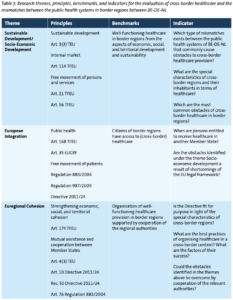Summary
Susanne Sivonen
Introduction
Although cross-border healthcare is essential especially for border regions, the differences among Member States and, in particular, among their health systems, may cause barriers to its citizens in accessing healthcare or other services in a cross-border setting. In the light of the objectives of Socio-economic/Sustainable Development, European Integration and Euregional Cohesion, this dossier examines the current challenges in cross-border healthcare and the mismatches of public health systems in the (cross-)border regions of Belgium, Germany, and the Netherlands. Since the Patients’ Rights Directive 2011/24/EU provides legislation on the access to cross-border healthcare in the European Union, the analysis focuses on an ex-post assessment of this law’s border effects. The underlying assumption is that cross-border healthcare is an essential element in cross-border regions to provide adequate living conditions for its citizens, since otherwise the individual national border regions suffer from shortcomings due to its remote geographical situation from national centres.
From this perspective, this dossier is an exploratory study and seeks to examine various obstacles arising in cross- border healthcare based on the benchmark of what amounts to well-functioning healthcare in cross-border regions (see table 7 below). Under the objective of Socio-Economic Development, the dossier assesses which mismatches between the respective public health systems have an effect on the mobility of citizens of (cross-) border regions. In relation to the European Integration objective, this dossier examines the state of play of the EU-level framework on cross-border healthcare. The dossier will analyse whether Directive 2011/24 is fit for purpose in light of the special characteristics and needs of cross-border regions. Considering the Directive’s potential for providing solutions to the border obstacles to the peculiar needs of patients’ mobility in cross-border regions, the dossier will conclude with a discussion on cross-border cooperation under the objective of Euregional cohesion. It will thus identify best practises of organising healthcare in a cross-border context.
As regards the geographical delimitation of the analysis, it is relevant that healthcare is a national prerogative. Therefore, the relevant border region under examination here comprises all the border regions shared between Belgium, the Netherlands and Germany.
Socio-economic/Sustainable Development: Mismatches between the public health systems
In these border regions, citizens often seek healthcare services across the border due to their geographical proximity. Access to well-functioning healthcare in cross-border regions not only contributes to the well-being of its population, but also is of essence from the aspects of economic, social, and territorial development and sustainability of these regions. However, due to their peripheral location and rising difficulties such as aging population, cross-border regions may be more vulnerable and face additional obstacles than non-border areas. Moreover, the COVID-19 crisis has reaffirmed the importance of cross-border cooperation in healthcare.[1]
In the field of public health, the European Union has a mere coordinating role. The organisation, delivery and financing of healthcare remains the competence of EU Member States[2], leading to diversity and differences between the respective health systems. The high mobility of citizens in border regions combined with the differences in health systems is nevertheless not always without obstacles. The casuistry of ITEM and the Border Information Points (GIP) is rich in examples that illustrate barriers to people’s free movement in a cross-border fashion resulting from the structural mismatch of national public health systems. Therefore, this dossier seeks to explore which (type of) mismatches between those public health systems adjacent to the Dutch border may commonly cause obstacles to cross-border use of healthcare provision.
An illustrative example of these obstacles is provided by the region Zeeuws-Vlaanderen, located in the Netherlands on the border with Belgium. The shrinking and aging population of the region brings a unique set of problems causing the deterioration of (available) public healthcare. Habitually, Belgian inhabitants have been seeking care across the border in the Netherlands due to its territorial proximity. However, it has been reported that there is an obstacle hindering the cross-border access of Belgian residents to Dutch healthcare services. Often residents of and insured in Belgium are unable to receive reimbursements for their planned medical care in the Netherlands, for which they need a permission from their Belgian health insurance company. As a result, the cross- border access to healthcare for inhabitants of the border region is limited and may further contribute to the deteriorating availability of healthcare on that side.[3]
This example is one among many daily situations that demonstrate the diversity of healthcare systems and the numerous challenges that can arise from them in a cross-border setting. It follows the question to what extent the EU’s system of enhancing the free movement of patients addresses these challenges, which are peculiar to cross- border territories.
European Integration: Cross-border healthcare within the EU legislative framework
Although the organisation of healthcare is the competence of the Member State, there is nonetheless EU level- legislation that deals with cross-border healthcare. One can find, on the one hand, the European social security coordination Regulations (Regulation 883/2004 and Implementing Regulation 987/2009), and on the other hand the Patients’ Rights Directive 2011/24 (based on case law from the Court of Justice of the EU). These instruments both regulate a variety of situations, laying down rules and conditions under which cross-border healthcare may be sought and reimbursed.[4] In contrast to the Regulations[5], the Directive furthermore strengthens co-operation in prescriptions, rare diseases and on health technology matters.[6] It, too, provides rules on complaint procedures and sets the rights of patients: the right to receive information and the right to medical follow-up.[7] As its main objective, the Directive aims to ensure patient mobility, facilitate access to safe and high-quality cross-border healthcare, and promote cooperation on healthcare between the Member States.[8]
Ten years after its adoption, the EU Patient Directive is currently under evaluation by the European Commission. Next to assessing whether the Directive operates efficiently, the Commission also focuses on mutual assistance and cooperation in healthcare in border regions.[9] In a similar vein, this dossier evaluates the effect of the Directive on patients’ rights and cross-border cooperation between Member States. The practical cases under the theme of Socio-Economic Development provide useful examples to classify the type of border obstacles that affect cross- border regions in particular and compare them with the Directive’s provision. It is important to evaluate whether these obstacles of cross-border healthcare arise from shortcomings of the EU legal framework: some do, whilst others occur in a purely national legal setting.
Euregional Cohesion: The EU Patients’ Rights framework fit for purpose?
Eventually, the dossier seeks to answer how the Directive could pay more attention to the needs of cross-border regions and furthermore promote the establishment of well-functioning healthcare in border regions. Are its provisions apt to meet the particular requirements of border regions’ residents? Can it, in its current design, accommodate the special characteristics of cross-border regions? These questions go hand in hand with the question if and how the type of border obstacles, mentioned at the beginning, could be solved in a structural rather than the usual ad hoc manner, which is often dependent on the involved authorities’ good will. More specifically, then, the dossier will also examine how these obstacles could be overcome by the regional authorities and identifies the best practises of organising healthcare in a cross-border context.

[1]
Communication from Commission: Guidelines on EU Emergency Assistance in Cross-Border Cooperation in Healthcare related to the COVID-19 crisis, C(2020) 2153 final. See also Dossier 3.
[2]
Article 168 TFEU.
[3]
B-solutions: Final Report by the Expert, ‘Cross-border healthcare and the reimbursement of cross-border healthcare costs – Provincie Zeeland’ 2021.
[4]
See Chapter 1 Regulation 883/2004, Chapter III Directive 2011/24.
[5]
Compared to the Directive, the Regulations have a broader scope on facilitating free movement of persons. The Regulations coordinate also other benefits than those related to cross-border healthcare, such as unemployment and family benefits.
[6]
See Chapter IV Directive 2011/24.
[7]
See Chapter II Directive 2011/24.
[8]
Recital 10 Directive 2011/24.
[9]
European Commission Roadmap: Evaluation of patients’ rights in cross-border healthcare, 14 January 2021.


